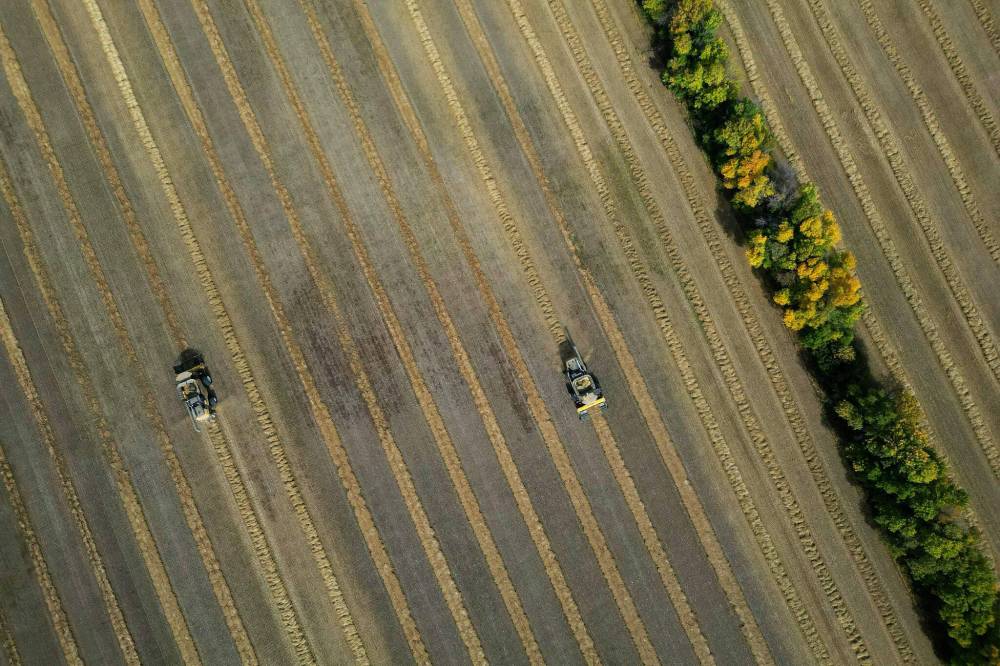Manitoba farms report lower net income, higher operating expenses
Advertisement
Read this article for free:
or
Already have an account? Log in here »
To continue reading, please subscribe:
Monthly Digital Subscription
$0 for the first 4 weeks*
- Enjoy unlimited reading on winnipegfreepress.com
- Read the E-Edition, our digital replica newspaper
- Access News Break, our award-winning app
- Play interactive puzzles
*No charge for 4 weeks then price increases to the regular rate of $19.00 plus GST every four weeks. Offer available to new and qualified returning subscribers only. Cancel any time.
Monthly Digital Subscription
$4.75/week*
- Enjoy unlimited reading on winnipegfreepress.com
- Read the E-Edition, our digital replica newspaper
- Access News Break, our award-winning app
- Play interactive puzzles
*Billed as $19 plus GST every four weeks. Cancel any time.
To continue reading, please subscribe:
Add Free Press access to your Brandon Sun subscription for only an additional
$1 for the first 4 weeks*
*Your next subscription payment will increase by $1.00 and you will be charged $16.99 plus GST for four weeks. After four weeks, your payment will increase to $23.99 plus GST every four weeks.
Read unlimited articles for free today:
or
Already have an account? Log in here »
Hey there, time traveller!
This article was published 30/11/2023 (706 days ago), so information in it may no longer be current.
Manitoba farms experienced a loss of net income amid higher operating expenses in 2022 despite a rise in food prices and payments to farmers, recent Statistics Canada data found.
Manitoba’s realized net farm income was $1.5 billion last year, a 2.1 per cent drop from the previous year.
Food costs were higher: canola prices rose 38.9 per cent nationally between 2021 and 2022; unprocessed milk jumped 11.3 per cent.

Tim Smith/The Brandon Sun FViles
Combines harvest millet in fields north of Carberry.
“To operate a farm now, the costs have gotten extremely high,” stated Charles Fossay, a director on Keystone Agricultural Producers’ board.
Operating costs on Manitoba farms hiked nearly 21 per cent in 2022, when compared to 2021, Statistics Canada reported. Total operating expenses after rebates were $7.3 billion
Farm cash receipts — showing farms’ revenue through product sales — rose 15.3 per cent year over year, to $9.8 billion, according to Statistics Canada.
Fossay recalled the cost of nitrogen fertilizer nearly doubling. He uses the product on his grain and oilseeds fields near Starbuck, Man.
“Fertilizer is a world market price,” he said. “When it comes in tight supply, the price goes up.”
He pointed to Russia’s invasion of Ukraine limiting gas supplies and a ramp up of demand for natural gas as the COVID-19 pandemic ended — both contributed to higher fertilizer prices.
Canada imposed sanctions, like a 35 per cent tariff, on most Russian goods after the eastern country invaded Ukraine.
Natural disasters like hurricanes also factored into the price lifts.
Statistics Canada recorded in 2022, nationally, the highest surge in farm operating expenses since 1979. It tracked a 52.5 per cent increase in machinery fuel expenses last year and a 20.7 per cent rise in commercial feed costs.
The 2021 drought in Manitoba and western Canada squeezed feed resources and grain production.
“I probably harvested half of what I normally grow,” Fossay relayed.
But demand was there — even more so with the Russian invasion and, at the time, a halt on grain coming from the region.
Wheat prices jumped 41.8 per cent last year compared to 2021. Farm cash receipts for wheat, excluding durum, hit $9.3 billion in Canada, a 28.6 per cent increase.
Cattle slaughters also increased in Canada. The number of cattle killed reached its highest level since 2006.
In Manitoba, payments for hog slaughters increased 9.8 per cent.
“There is definitely some pretty significant variability from farm to farm,” noted Tyler Fulton, past-president of the Manitoba Beef Producers.
Some sectors fared better than others in 2022. Many Manitoba grain producers have been profitable; hog farmers struggled with high feed prices, he said.
This year, Fulton has clocked higher costs for machinery and services like plumbing. Farmers have been bearing the brunt of interest rate increases, noted Fossay.
“If we’re talking about last year, we incurred the extra costs but hadn’t seen any benefit on the value of our production,” said Fulton, a beef farmer. “That really narrowed our operating margins.”
This year, beef prices surged, though not so much at the retail level, Fulton added.
“I think we’re still in the thick of it,” he guessed. “We will probably be looking at higher prices into next year.”
Fossay has seen a flattening of input costs like fertilizer. Grain prices have dropped — Russia is selling grain at “fire sale prices,” Fossay stated.
“They’re selling grain at very cheap prices, below my cost of production,” he said. “Right now, that’s a concern that we’re having — what’s going to happen to the rest of our crop year and into 2024?”
He’s hoping for a removal of the carbon tax on grain dryer fuel and fuels used to heat livestock buildings — it’d reduce farmers’ operating costs, he said.
gabrielle.piche@winnipegfreepress.com

Gabrielle Piché reports on business for the Free Press. She interned at the Free Press and worked for its sister outlet, Canstar Community News, before entering the business beat in 2021. Read more about Gabrielle.
Every piece of reporting Gabrielle produces is reviewed by an editing team before it is posted online or published in print — part of the Free Press‘s tradition, since 1872, of producing reliable independent journalism. Read more about Free Press’s history and mandate, and learn how our newsroom operates.
Our newsroom depends on a growing audience of readers to power our journalism. If you are not a paid reader, please consider becoming a subscriber.
Our newsroom depends on its audience of readers to power our journalism. Thank you for your support.

